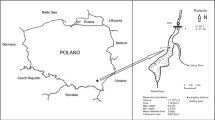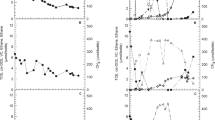Abstract
This study reports the first ethanol and acetaldehyde measurements in sediment porewaters collected at multiple freshwater locations. Ethanol concentrations ranged from 11 to 2535 nM and acetaldehyde concentrations ranged from 6 to 320 nM. A significant positive correlation (p < 0.001) was observed between ethanol concentrations and the percent organic carbon content of sediments (TOC). Porewater depth profiles at two sites within the same lake indicated potential diffusion of ethanol into sediments from the overlying water at a lower TOC site and upwards diffusion from sediment into the water column at a higher TOC site. Diffusion of water column ethanol into sediments was observed at individual sites from October to January, whereas the opposite was true from June to August indicating the seasonal variability of ethanol flux from sediments. Changes in ethanol concentrations during a long-term sediment incubation experiment showed an inverse relation with acetaldehyde concentrations. The lack of a quantitative conversion was likely due to other sources and sinks that control their abundance. Our study provided new information on the biogeochemistry of ethanol in freshwater sediments and shed light on the potential role of ethanol in the global carbon cycle.






Similar content being viewed by others
References
Alperin MJ, Blair NE, Albert DB, Hoehler TM, Martens CS (1992) Factors that control the stable carbon isotopic composition of methane produced in an anoxic marine sediment. Glob Biogeochem Cycles 6:271–291
Avery GB, Shannon RD, White JR, Martens CS, Alperin MJ (2003a) Controls on methane production in a tidal freshwater estuary and a peatland: methane production via acetate fermentation and CO2 reduction. Biogeochemistry 62:19–37
Avery GB, Willey JD, Kieber RJ, Shank GC, Whitehead RF (2003b) Flux and bioavailability of Cape Fear River and rainwater dissolved organic carbon to Long Bay, southeastern United States. Glob Biogeochem Cycles 17:1042
Barnhill (1992) Soil Survey of Onslow County, North Carolina. U.S. Department of Agriculture, Soil Conservation Service
Biebl H, Pfennig N (1977) Growth of sulfate-reducing bacteria with sulfur as electron acceptor. Arch Microbiol 112:115–117
Bryant MP (1979) Microbial methane production—theoretical aspects. J Anim Sci 48:193–201
Carnegie D, Ramsay JA (2009) Anaerobic ethylene glycol degradation by microorganisms in poplar and willow rhizospheres. Biodegradation 20:551–558
Chanton JP, Martens CS, Kelley CA (1989) Gas-transport from methane-saturated, tidal fresh- water and wetland sediments. Limnol Oceanogr 34:807–819
Dwyer DF, Tiedje JM (1986) metabolism of Polyethylene glycol by Two anaerobic Bactria, desulfovibrio desulfuricans and a Bacteroides sp. Appl Environ Microbiol 52:852–856
Gottschalk G (1979) Bacterial metabolism. Springer, New York
Grey EC (1913) The Production of Acetaldehyde during the Anaerobic Fermentation of Glucose by Bacillus coli communis (Escherich). Biochem J 7:359–363
Hallin S, Pell M (1998) Metabolic properties of denitrifying bacteria adapting to methanol and ethanol in activated sludge. Water Res 32:13–18
Hedges JI, Stern JH (1984) Carbon and nitrogen determinations of carbonate-containing solids. Limnol Oceanogr 29:657–663
Hesslein RH (1976) An in situ sampler for close interval pore water studies. Limnol Oceanogr 21:912–914
Ingvorsen K, Zehnder AJB, Jørgensen BB (1984) Kinetics of sulfate and acetate uptake by desulfobacter postgatei. Appl Environ Microbiol 47:403–408
Inversen N, Jørgensen BB (1985) Anaerobic methane oxidation at the sulfate-methane transition in marine sediments from Kattegat and Skagerrak (Denmark). Limnol Oceanogr 30(5):944–955
Kelley CA, Martens CS, Chanton JP (1990) Variations in sedimentary carbon remineralization rates in the White Oak River estuary, North Carolina. Limnol Oceanogr 35:372–383
Kennedy RA, Rumpho ME, Fox TC (1992) Anaerobic metabolism in plants. Plant Physiol 100:1–6
Kieber RJ, Mopper K (1990) Determination of picomolar concentrations of carbonyl compounds in natural waters, including seawater, by liquid chromatography. Environ Sci Technol 24:1477–1481
Kieber RJ, Guy AL, Roebuck JA, Carroll AL, Mead RN, Jones SB, Giubbina FF, Campos MLAM, Willey JD, Avery GB (2013) Determination of ambient ethanol concentrations in aqueous environmental matrixes by two independent analyses. Anal Chem 85:6095–6099
Kirstine WV, Galbally IE (2012a) The global atmospheric budget of ethanol revisited. Atmos Chem Phys 12:545–555
Kirstine WV, Galbally IE (2012b) Ethanol in the environment: a critical review of its roles as a natural product, a biofuel, and a potential environmental pollutant. Crit Rev Environ Sci Technol 42:1735–1779
Lavery PS, Oldham CE, Ghisalberti M (2001) The use of Fick’s first law for predicting porewater nutrient fluxes under diffusive conditions. Hydrol Process 15:2435–2451
Lovley DR, Klug MJ (1983) Methanogenesis from methanol and methylamines and acetogenesis from hydrogen and carbon dioxide in the sediments of a eutrophic lake. Appl Environ Microbiol 45:1310–1315
Lovley DR, Phillips EJP (1988) Novel mode of microbial energy metabolism: organic carbon oxidation coupled to dissimilatory reduction of iron or manganese. Appl Environ Microbiol 54:1472–1480
Mallin MA, McIver MR, Merritt JF (2013) Environmental assessment of the lower cape fear river system, 2012. In: Science CfM (Ed). University of North Carolina Wilmington
Martens CS, Goldhaber MB (1978) Early diagenesis in transitional sedimentary environments of White Oak River estuary, North Carolina. Limnol Oceanogr 23:428–441
McKinney RE, Jeris JS (1955) Metabolism of low molecular weight alcohols by activated sludge. Sew Ind Wastes 27:728–735
Metje M, Frenze P (2005) Effect of temperature on anaerobic ethanol oxidation and methanogenesis in acidic peat from a northern wetland. Appl Environ Microbiol 71:8191–8200
Millet DB, Guenther A, Siegel DA, Nelson NB, Singh HB, deGouw JA, Warneke C, Williams J, Eerdekens G, Sinha V, Karl T, Flocke F, Apel E, Riemer DD, Palmer PI, Barkley M (2010) Atmos Chem Phys 10:3405–3425
Naik V, Fiore AM, Horowitz LW, Singh HB, Wiedinmyer C, Guenther A, deGouw JA, Millet DB, Goldan PD, Kuster WC, Goldstein A (2010) Observational constraints on the global atmospheric budget of ethanol. Atmos Chem Phys 10:5361–5370
Oremland RS (1988) Biogeochemistry of methanogenic bacterica. In: Zehnder AJB (ed) Biology of anaerobic microorganisms. Wiley, New York, pp 641–705
Oremland RS, Marsh LM, Polcin S (1982) Methane production and simultaneous sulphate reduction in anoxic, salt marsh sediments. Nature 296:143–145
Sexton S (2002) Rates of carbon remineralization in coastal wetland sediments under sulfate reducing and methanogenic conditions: implications for sea-level rise. Department of Chemistry and Biochemistry. University of North Carolina Wilmington, Wilmington, NC
Widdel F (1988) Microbiology and ecology of sulfate- and sulfur-reducing bacteria. In: Zehnder AJB (ed) Biology of anaerobic microorganisms. Wiley, New York, pp 469–585
Xie S, Lazar CS, Lin Y, Teske A, Hinrichs K (2013) Ethane- and propane-producing potential and molecular characterization of an ethanogenic enrichment in an anoxic estuarine sediment. Org Geochem 59:37–48
Zhuang G-C, Lin Y-S, Elvert M, Heuer VB, Hinrichs K-U (2014) Gas chromatographic analysis of methanol and ethanol in marine sediment pore waters: validation and implementation of three pretreatment techniques. Mar Chem 160:82–90
Acknowledgments
The National Science Foundation Grants AGS 1003078, OCE 1154850, and OCE 0825538 provided funding for this work. The authors would also like to thank the many undergraduate and graduate students who contributed to this work.
Author information
Authors and Affiliations
Corresponding author
Rights and permissions
About this article
Cite this article
Roebuck, J.A., Avery, G.B., Felix, J.D. et al. Biogeochemistry of Ethanol and Acetaldehyde in Freshwater Sediments. Aquat Geochem 22, 177–195 (2016). https://doi.org/10.1007/s10498-015-9284-9
Received:
Accepted:
Published:
Issue Date:
DOI: https://doi.org/10.1007/s10498-015-9284-9




